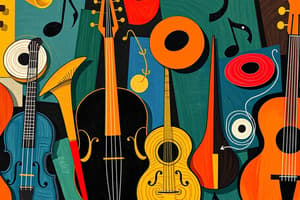Podcast
Questions and Answers
Bagian dari instrumen pukul yang berfungsi untuk menekan kepala drum dan mendukung struktur instrumen adalah?
Bagian dari instrumen pukul yang berfungsi untuk menekan kepala drum dan mendukung struktur instrumen adalah?
- Hoops (correct)
- Tuning Keys atau Lugs
- Stiks dan Mallets
- Snares dan Ropes
Bagian dari instrumen non-pukul yang biasanya terbuat dari kayu spruce atau maple dan berfungsi untuk memperkuat getaran senar adalah?
Bagian dari instrumen non-pukul yang biasanya terbuat dari kayu spruce atau maple dan berfungsi untuk memperkuat getaran senar adalah?
- Soundboard (correct)
- Neck
- Bridge
- Nut
Fungsi dari Fingerboard pada instrumen non-pukul adalah?
Fungsi dari Fingerboard pada instrumen non-pukul adalah?
- Mengatur ketegangan senar
- Memegang fret tempat pemain menggeser jari (correct)
- Menahan senar di ujungnya
- Menghubungkan senar dengan soundboard
Bagian dari instrumen pukul yang berisi kawat kecil di bawah kepala drum sehingga saat dipukul, kawat tersebut bergetar dan menambah suara retak tajam adalah?
Bagian dari instrumen pukul yang berisi kawat kecil di bawah kepala drum sehingga saat dipukul, kawat tersebut bergetar dan menambah suara retak tajam adalah?
Bagian dari instrumen non-pukul yang digunakan untuk menghubungkan senar dengan soundboard sambil menjaganya tetap sejajar dengan nut adalah?
Bagian dari instrumen non-pukul yang digunakan untuk menghubungkan senar dengan soundboard sambil menjaganya tetap sejajar dengan nut adalah?
Fungsi utama dari Strings pada instrumen non-pukul adalah?
Fungsi utama dari Strings pada instrumen non-pukul adalah?
Apa yang dimaksud dengan 'Body' pada instrumen perkusi?
Apa yang dimaksud dengan 'Body' pada instrumen perkusi?
Apa yang menjadi fungsi dari 'Head' pada instrumen perkusi?
Apa yang menjadi fungsi dari 'Head' pada instrumen perkusi?
Bahan apa yang umumnya digunakan untuk membuat 'Body' instrumen perkusi?
Bahan apa yang umumnya digunakan untuk membuat 'Body' instrumen perkusi?
Apa yang menjadi perbedaan utama antara instrumen perkusi dan non-perkusi?
Apa yang menjadi perbedaan utama antara instrumen perkusi dan non-perkusi?
Apa yang dimaksud dengan 'Head' pada instrumen perkusi?
Apa yang dimaksud dengan 'Head' pada instrumen perkusi?
Apakah yang mempengaruhi pitch dari instrumen perkusi?
Apakah yang mempengaruhi pitch dari instrumen perkusi?
Flashcards are hidden until you start studying
Study Notes
Musical Instruments: Understanding Their Components
Musical instruments come in various shapes, sizes, and forms, each designed to produce unique sounds and tones. These instruments can broadly be categorized into two main types: percussion and non-percussion. While percussion instruments rely on vibrations produced by striking, shaking, or blowing them, non-percussion instruments create sound through the vibration of strings or columns of air.
This article explores the essential components of both percussion and non-percussion instruments, providing a deeper understanding of how these devices work.
Parts Common to Percussion Instruments
Percussion instruments include drum kits, maracas, tambourines, triangles, castanets, cymbals, bongos, djembes, congas, dholak, tabla, bodhrán, marimba, xylophone, vibraphone, timpani, and many others. Some common elements found across these instruments include:
-
Body: This is the main structure of the instrument. It may be made of wood, metal, plastic, or any other suitable material. For example, snare drums have a cylindrical body, while maracas have a hard shell.
-
Head: Placed over the body, heads are often made of animal skin stretched tightly over a wooden frame. They can also be made from materials like plastics, rubber, mylar, synthetics, or fiberglass. The head influences the pitch of the instrument; thicker heads give lower pitches, while thinner ones result in higher notes.
-
Sticks and Mallets: Used to strike the head directly or indirectly via beaters attached to the instrument itself (e.g., drumsticks).
-
Snares and Ropes: Found mainly in drum bodies, snares consist of small wires or strands that run beneath the head. When struck, the vibrating head causes the snares to oscillate, adding a sharp cracking sound to the note played.
-
Tuning Keys or Lugs: Located around the edge of the drum body, these keys allow tuning the tension of the head.
-
Hoops: A circular piece of metal, wood, or plastic used to hold the head in place and support the structure of the instrument.
Percussion instruments generally require little maintenance compared to their non-percussive counterparts, which is part of what makes them popular among beginners and professionals alike.
Non-Percussion Instrument Parts
Non-percussion instruments encompass a wide range of stringed and wind/brass instruments such as violins, cellos, pianos, flutes, trumpets, clarinets, oboes, saxophones, harmonicas, harps, guitars, sitar, and many more. Key elements shared by most of these instrumental types include:
-
Body: Depending on the design, this could refer to a hollow chamber housing the soundboard for stringed instruments or various tubes connected together for brass/woodwind instruments.
-
Soundboard: Typically composed of spruce or maple woods, its primary function is to amplify the vibration of the strings to generate sound.
-
Bridge: Connecting the strings to the soundboard while keeping them aligned with the nut.
-
Neck: Attached to the body, it holds the fingerboard where players fret notes.
-
Fingerboard: Often made of rosewood or ebony, it lies on top of the neck and houses frets along which the player positions fingers.
-
Nut: A small component located at the end of the fingerboard toward the bridge. It supports the strings near their ends when they're in a relaxed state.
-
Strings: Made primarily of gut, silk, steel, nylon, or synthetic materials, they transmit sound waves produced by the vibration of the instrument's soundboard.
In conclusion, understanding the basic components of musical instruments enables musicians to maintain them properly and customize their playing styles effectively. Whether you're just starting out or seeking to enhance your skills, knowing these details will significantly contribute to your proficiency as a musician!
Studying That Suits You
Use AI to generate personalized quizzes and flashcards to suit your learning preferences.




